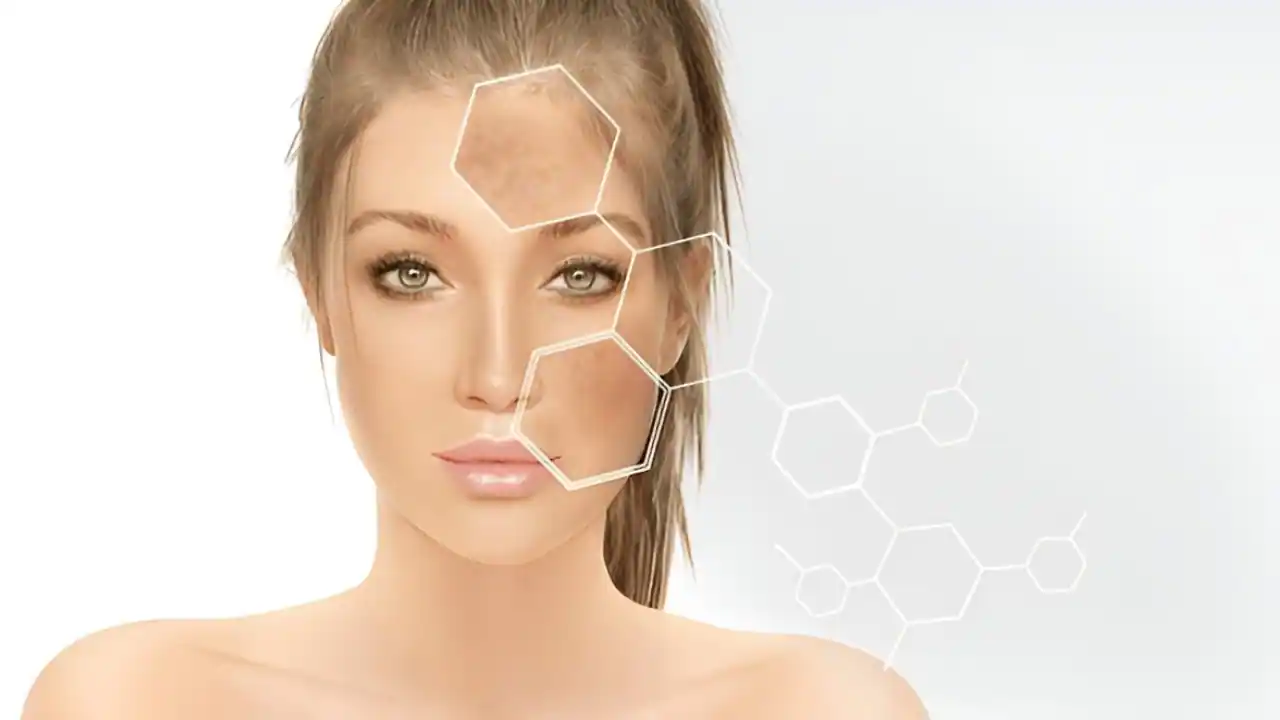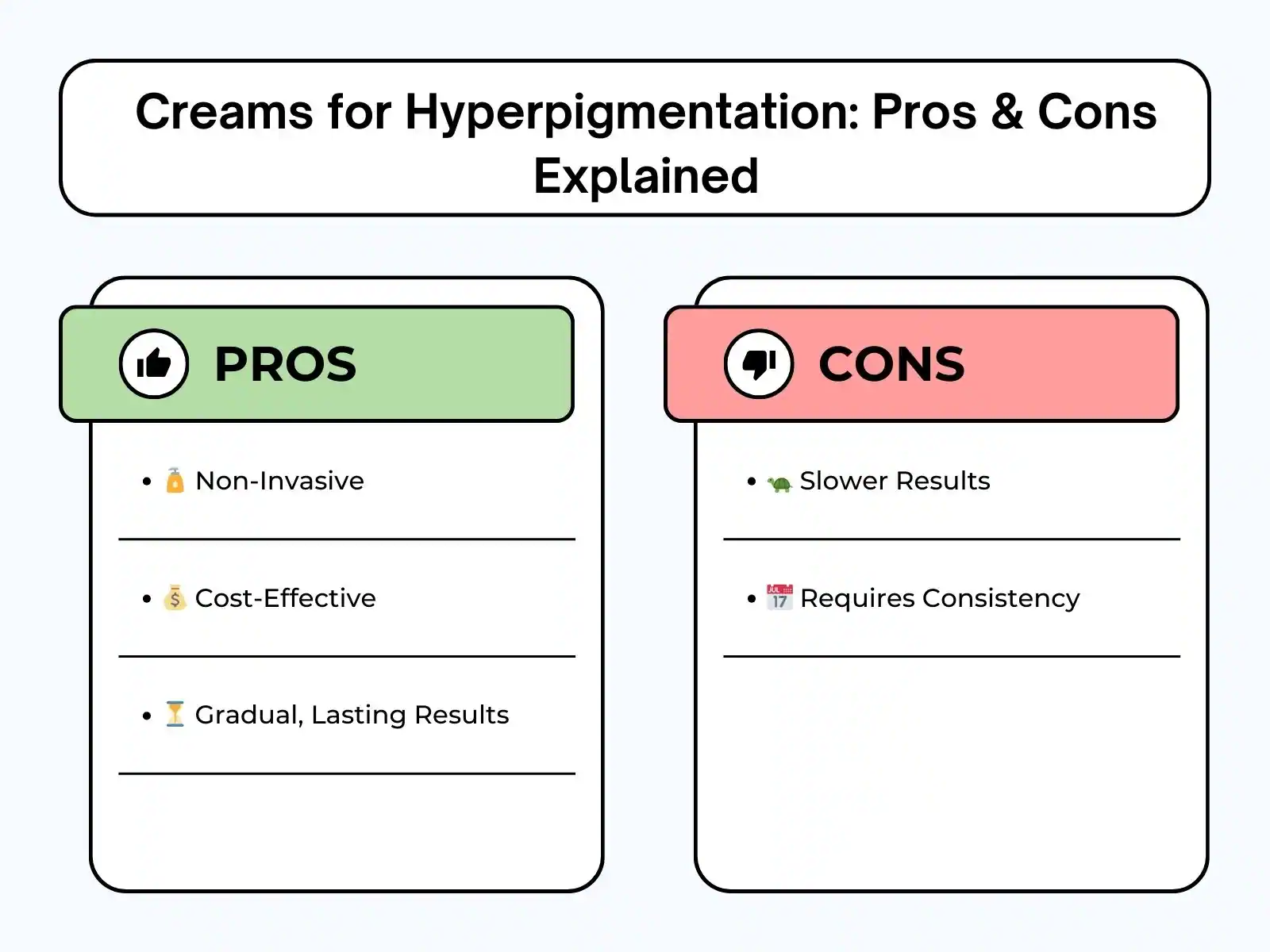
Hyperpigmentation is a common skin condition encountered by numerous people. It manifests as darkened skin spots, often caused by excessive melanin production in the affected areas. Spots from hyperpigmentation emerge on the face, areas of skin, or other body parts from three primary causes: exposure to sunlight, acne scars, hormonal shifts, and cut skin.
While hyperpigmentation isn’t harmful, the implications of hyperpigmentation can have a major toll on someone’s confidence. With a multitude of treatment options available, selecting the most appropriate therapy for hyperpigmentation treatment can be a difficult proposal to most. In this article, we explore the most popular pigmentation treatment methods — lasers, peels, and creams —to help you identify the proper therapy for your skin.
What Is Hyperpigmentation?
Hyperpigmentation refers to the darkening of the skin because of excessive melanin production, which controls the color of skin, eyes and hair in humans. People can develop hyperpigmentation due to multiple factors that include:
- Sun exposure: Extended time under UV sunlight’s radiation produces melanin multiplication, which forms sunspots or age spots on the skin surface.
- Acne scars: Acne scarring results in post-inflammatory hyperpigmentation (PIH) that produces dark spots after the acne breakouts heal.
- Hormonal changes: Pregnancy, together with birth control, creates conditions that bring about melasma or other forms of hyperpigmentation.
- Skin trauma: When subjected to any form of damage or harm to its surface, the skin creates darker healing areas.
Laser Treatment for Hyperpigmentation
Lasers are considered to be among the most effective solutions for hyperpigmentation treatment. The treatment employs laser technology, which specifically destroys excess pigment while the skin medicinally sheds away the darker pigmented skin cells.
What Is Laser for Pigmentation?
Laser therapies have proven to be highly efficient at treating hyperpigmentation of various skin pigments. Different laser types serve in pigmentation treatments with the following options available:
- Fractional CO2 Laser: It functions as an effective tool to eliminate acne scars and treat sun damage in deeper skin areas.
- Q-switched ND Yag Laser: The method functions as a pigmentation treatment device mostly for dark spots along with pigmentation.
- Picosecond Laser: This treatment system applies minimal force to treat hyperpigmentation effectively.
Hyperpigmentation laser treatment can identify pigmented cells that break down melanin content. Due to collagen stimulation during treatment, patients achieve skin that feels smoother and has an even texture.

Pros of Laser Treatment for Hyperpigmentation
- Quick Results: Laser treatments deliver quick skin improvement benefits to numerous patients through multiple therapy sessions.
- Precision: Laser technology permits healthcare providers to focus on treating pigmented cells only without affecting healthy skin tissue.
- Long-Term Results: After the reduction of skin pigmentation the condition should stay improved through proper sun protection.
Cons of Laser Treatment for Hyperpigmentation
- Cost: Laser treatment sessions tend to raise the overall cost as the procedures require multiple sessions.
- Downtime: Recuperation time may account for several days for individuals who need laser treatments of specific types.
Chemical Peels for Hyperpigmentation
Chemical peels are fast becoming a top-choice approach to treating hyperpigmentation. People who undergo chemical peels receive solutions that exfoliate the skin’s top layer, triggering regeneration.
What Is a Chemical Peel for Hyperpigmentation?
In the chemical peel method, glycolic acid, salicylic acid and trichloroacetic acid (TCA) are commonly used for treating hyperpigmentation by removing dead skin cells. The strength level of chemical peels varies from light to deep depending on the extent of the hyperpigmentation for which patients need treatment.
Pros of Chemical Peels for Hyperpigmentation
- Diverse range: The treatment works well for people with sunspots and post-acne skin discolorations that primarily affect the surface of their skin.
- Quick Recovery: Patients recover from light and medium peels within a week after treatment.
- Increased Collagen Production: Mild Chemical Peels enhance collagen output similarly to laser treatments, which leads to improved skin texture.
Cons of Chemical Peels for Hyperpigmentation
- Multiple sessions required: Desired results need multiple peeling sessions, especially in case of more stubborn pigmentation.
- Not Ideal for All Skin Types: Light to medium skin complexions run a risk of their pigmentation getting worse under the chemical peel method.
Creams and Topical Treatments for Hyperpigmentation
Hyperpigmentation can be successfully treated with topical creams if you are looking for a budget-friendly and minimally invasive option. The creams typically include components that both reduce melanin production and gradually fade dark spots from the skin.
What Are the Best Creams for Hyperpigmentation?
The most effective element in skin care products is the use of combinations of the following compounds:
- Hydroquinone: The bleaching agent, hydroquinone, functions to decrease the production of melanin in the skin cells. Hydroquinone is one of the top options when treating hyperpigmentation.
- Vitamin C: The brightening properties of Vitamin C soften the dark spots in the skin, making it more uniform.
- Retinoids: The cell-regenerating properties of retinoids lead to diminishing hyperpigmentation over time.
- Niacinamide: The antioxidant properties of Niacinamide regulate dark spots on the skin and simultaneously enhance skin texture.
- Alpha Hydroxy Acids (AHAs): Superficial skin pigmentation benefits from AHAs, including glycolic acid, that effectively removes dead skin cells.
Pros of Using Creams for Hyperpigmentation
- Non-Invasive: You can apply creams easily without requiring downtime, which makes them perfect for both at-home and self-use purposes.
- Cost-Effective: Topical treatments are much less expensive than both lasers and chemical peels.
- Gradual Results: The method provides extended-lasting results that people maintain upon consistent use.
Cons of Using Creams for Hyperpigmentation
- Slower Results: The improvement process with creams moves at a slower pace than both peels and laser procedures.
- Consistency Is Key: Continued application of these creams demands long-term dedication for maximum results.
Choosing the Best Treatment for Hyperpigmentation
People face the challenge of picking between laser treatment and chemical peels as well as topical creams to manage their hyperpigmentation condition.
- Severity of Hyperpigmentation: Your decision between laser treatments should focus on deep or extensive pigmentation because lasers tend to provide the fastest and most obvious treatment outcomes. Individuals with gentle spots would need either a chemical peel or topical treatment.
- Skin Type: Patients with darker skin tones need to avoid chemical peels since they might not suit their specific skin type. The selection of correct dermatological treatment depends on your skin type, so seek help from a dermatologist.
- Budget and Lifestyle: Laser treatments together with chemical peels cost more money and need multiple treatment sessions, but topical creams provide lower costs and daily home application.
- Downtime: Assess your availability to recover from the treatment to determine which approach to take.

